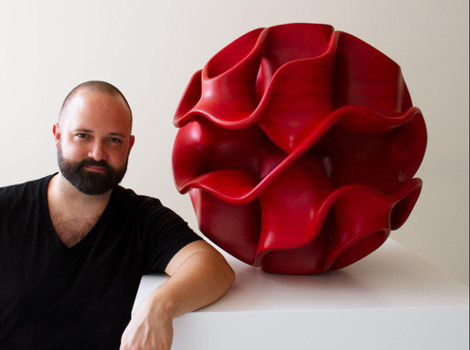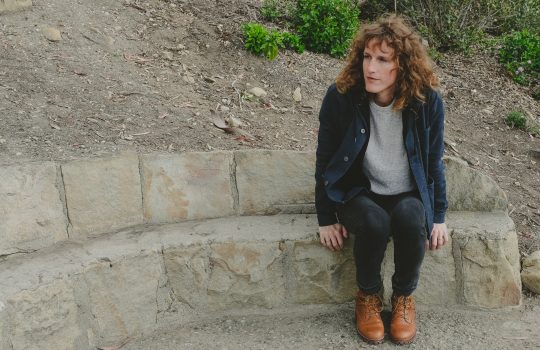Current artist-in-residence Jim Jenkins will end his tenure with an exhibit in January
The U.S. Department of Energy’s Fermi National Accelerator Laboratory is pleased to announce that New York-based photographer Adam Nadel has been selected as the lab’s artist-in-residence for 2018.
Nadel’s work lives in the place where journalism and art collide. His most recent exhibit, “Getting the Water Right,” examines the people and science involved in the Florida Everglades ecosystem, putting a human face to restoration efforts. His previous touring exhibitions investigated the global impact of malaria and the effects of violence on noncombatants in Darfur, Baghdad and other places. His work has received numerous awards and grants, including a Pulitzer Prize nomination in 2006, with over a dozen solo museum exhibitions both nationally and internationally.
Nadel began his career as a photojournalist, first serving as the photo editor for the University of Chicago’s student paper, the Maroon, while earning his undergraduate degree. He then landed several high-profile photojournalism assignments. Many of his exhibits, including “Non-Combatants,” were created in tandem with his journalism work.
“After a while I began to see that what I valued was different than what I originally thought I would be interested in,” Nadel said of his photojournalism career. “I migrated away from spot news and into using the visual lexicon to formulate larger ideas.”
Nadel refers to himself as a craftsperson, rather than as an artist, and his work focuses on finding the human element in complex ecosystems. Although there is a component of activism in exhibits like “Getting the Water Right,” Nadel prefers to document without pushing an agenda.
“I see what I do as fundamentally trying to communicate the worlds that I am visiting, not to interpret them to say something about them,” he said. “What I find interesting is providing everyone with the facts to create agreed-upon relationships, whether it be water systems or political systems. If we can agree on those facts, we can begin to have a reasonable conversation with an outcome based in mutual understanding.”

“Sod field”
Reclaimed Everglades
South Bay, Florida
2012
Part of the “Getting the Water Right” series
Copyright Adam Nadel
Nadel has never visited Fermilab before but is an avid reader of books and articles on physics. He plans four trips to the lab over the next year to document both the science and the people behind it. While many photographers in his position would concentrate on the complexity and symmetry of the massive science machines at Fermilab, Nadel said he is interested in connecting those machines to the human element that guides the laboratory.
“Photographically that mechanical side seems removed from what we see as humanity,” he said. “It’s beautiful, but is that all we’ve got? Science is inherently a human endeavor, and I hope to build a bridge linking people to the science they create.”
Nadel will give a brief talk on Friday, Jan. 26, at 2:30 p.m. in Fermilab’s Curia II conference room (adjacent to the Fermilab Art Gallery) on his selection as the 2018 artist-in-residence. The public is welcome to attend.
Fermilab launched the artist-in-residence program in 2014 as a way of connecting the laboratory’s science with new audiences using the medium of art. Nadel is the first photographer and first out-of-state artist chosen for the program. Oak Brook textiles artist Lindsay Olson was the first artist-in-residence in 2015, and Chicago multimedia artist Ellen Sandor of (art)n held the position in 2016.
The selected artist-in-residence completes his or her residency with an exhibit in the Fermilab Art Gallery. Sculptor Jim Jenkins of Geneva, Illinois, the current artist-in-residence, opened his show, titled “A Perplexity of Conundrums,” on Monday, Jan. 8, and will attend a free public artist’s reception on Friday, Jan. 12, from 5-7 p.m. in the Fermilab Art Gallery. The show will run through March 2.

“Armando Najera Ramos”
Temporary foreign worker
La Belle, Florida
2014
Part of the “Getting the Water Right” series
Copyright Adam Nadel
Jenkins will also collaborate in a multimedia show called “Dark Matters” on Sunday, Jan. 21, combining his work with a performance of Olivier Messiaen’s “Quartet for the End of Time.” The show will feature Jenkins’s piece “Angel of the Apocalypse,” which incorporates pieces of Fermilab’s E760 detector, the centerpiece of an experiment that ran in the early 1990s. Tickets for that performance are on sale now.
“We’ve been pleased to have Jim Jenkins as our artist-in-residence this year, and I’m excited for everyone to see what he’s been working on,” said Georgia Schwender, curator of the Fermilab Art Gallery. “And I’m very much looking forward to working with Adam Nadel on new ways to present Fermilab’s scientific work to artistically minded audiences.”
See more of Nadel’s work at his website: http://adamnadel.com.
Fermilab is America’s premier national laboratory for particle physics and accelerator research. A U.S. Department of Energy Office of Science laboratory, Fermilab is located near Chicago, Illinois, and operated under contract by the Fermi Research Alliance LLC, a joint partnership between the University of Chicago and the Universities Research Association Inc. Visit Fermilab’s website at www.fnal.gov and follow us on Twitter at @Fermilab.
The DOE Office of Science is the single largest supporter of basic research in the physical sciences in the United States and is working to address some of the most pressing challenges of our time. For more information, please visit science.energy.gov.




